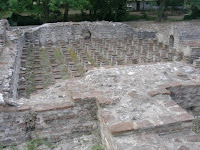By Jeff Burns
 |
Roman Baths by Giovanni Paolo Pannini
|
Communal
bathing has been an important part of many cultures around the word for
millennia. The earliest public baths
discovered by archaeologists were in the Indus River Valley city of
Mohenjo-Daro, which was built in the third millennium BC. The ancient Romans built bathhouses on the
frontiers as they expanded their empire.
Communal bathing was and is a vital part of Japanese culture, and the
sauna culture still thrives in Scandinavia. Not only did the practice meet a
need for cleanliness and develop a reputation for having healing properties,
but baths were also often an important part of rituals and religion, and they
were an important part of building a spirit of community.


Over
time, however, public bathing facilities diminished in western Europe and the
United States as private bathing
facilities became more commonly available, and, in some cases, bathhouses came
to be associated with brothels and other illicit behavior. However, the modern spa boom could mean a
welcome resurgence.
My
first experience of a traditional bath house was in Baden-Baden Germany several
years ago when I was traveling in Germany, Austria, and the Czech
Republic. There is a communal bathing
tradition in all those countries, but Baden-Baden literally meaning “bathing-bathing”,
is legendary. Roman troops once bathed
in the warm mineral springs as early as the reign of Emperor Hadrian when the
settlement was known as Aquae. Later, royalty
from across Europe took advantage of the supposedly curative waters. Mark Twain visited on his famous European
tour, immortalized in his works Innocents Abroad and “A Tramp Abroad.”
In fact, the very spa he visited, Friedrichsbad http://www.baden-baden.de/en/health-wellness/thermal-baths/friedrichsbad-the-roman-irish-bath/
, still operates, little changed from the days of his visit. Of Friedrichsbad,
Twain wrote, “Here at the
Friedrichsbad you lose track of time within 10 minutes and track of the world
within 20....”
Friedrichsbad
stil practices the traditional bathing rules.
There is a 17 step ritual, with the steps consisting of baths and saunas
of various temperatures, hot to cold, wraps, and a vigorous body scrup with soap and a hard-bristled
brush. The bather is nude for all these
steps, and men and women are segregated, except for a common pool which is
optional. All this takes place in the
original structure, built in the late 1800s and beautifully decorated with
tiles and frescoes, just as it was when Twain visited.
I’ve
also enjoyed similar experiences in the U.S. a few times. Hot Springs Arkansas was named for the
springs first enjoyed by Native Americans.
As settlers moved west, they discovered the benefits and pleasures, and
the town became a southern resort city, famous for horse racing, casinos, and
gangsters in the 1920s. The downtown
business district was lined with luxurious bathhouses which thrived. Business later fell off, however, and the
downtown district is now a national historic district. There are still several modern spas that use
the springs in their treatment, but only one still in operation and doing it
the traditional way, the Buckstaff BathHouse on Historic Bathhouse Row (http://www.buckstaffbaths.com/
). Sexes are segregated here as well,
and there are several steps in your visit.
The bather is greeted by an attendant who takes him through the
experience, starting with a soak in a huge tub filled with spring water at
about 100 degrees. Then, the bather goes
through a sitz bath, a cold shower, a sauna, and a wrap, with massage and other
services optional.
My
most recent experience was closer to home at Jeju Sauna in Duluth, Georgia (http://jejusauna.com/
). Jeju is a traditional Korean bath/spa
experience, popular with Asians and non-Asians alike. In the gender-segregated locker room bathing
area, there are showers, sinks, a hot tub, medium tub, icy cold tub, wet sauna,
dry sauna, infrared light drying area, and body scrub and acupressure massage
tables. From there, you can dress in the
t-shirt and shorts provided and go into the common, mixed gender area. There,
you will find a pool, a Korean restaurant, and large sauna huts and rooms. Each of these saunas is constructed of a
different material like gold and silver, jade, charcoal, salt, clay, and ice.
Some are hot, some are not. Each material
is touted to have different therapeutic benefits from which to choose. Foot reflexology and other services are also
offered. Admission is $25 (other
services additional) and good for 24 hours, so some people actually opt to
spend the night at Jeju instead of a hotel.




All images from www.jejusauna.com Salt room, Jade Room, Bath area, outside of
Salt Room
Whether
you’re traveling or you have an establishment in your hometown, consider trying
this experience. If you’re a little
squeamish about the nudity, there are some facilities that allow or even
require bathing suits. However, once you
dive in, pun intended, it really isn’t much of an issue. Check out TripAdvisor or other travel and
review sites and prepare for hours of relaxation, while enjoying an historic
tradition as old as civilization itself.
I look forward to trying Russian and Turkish baths in future travels.









